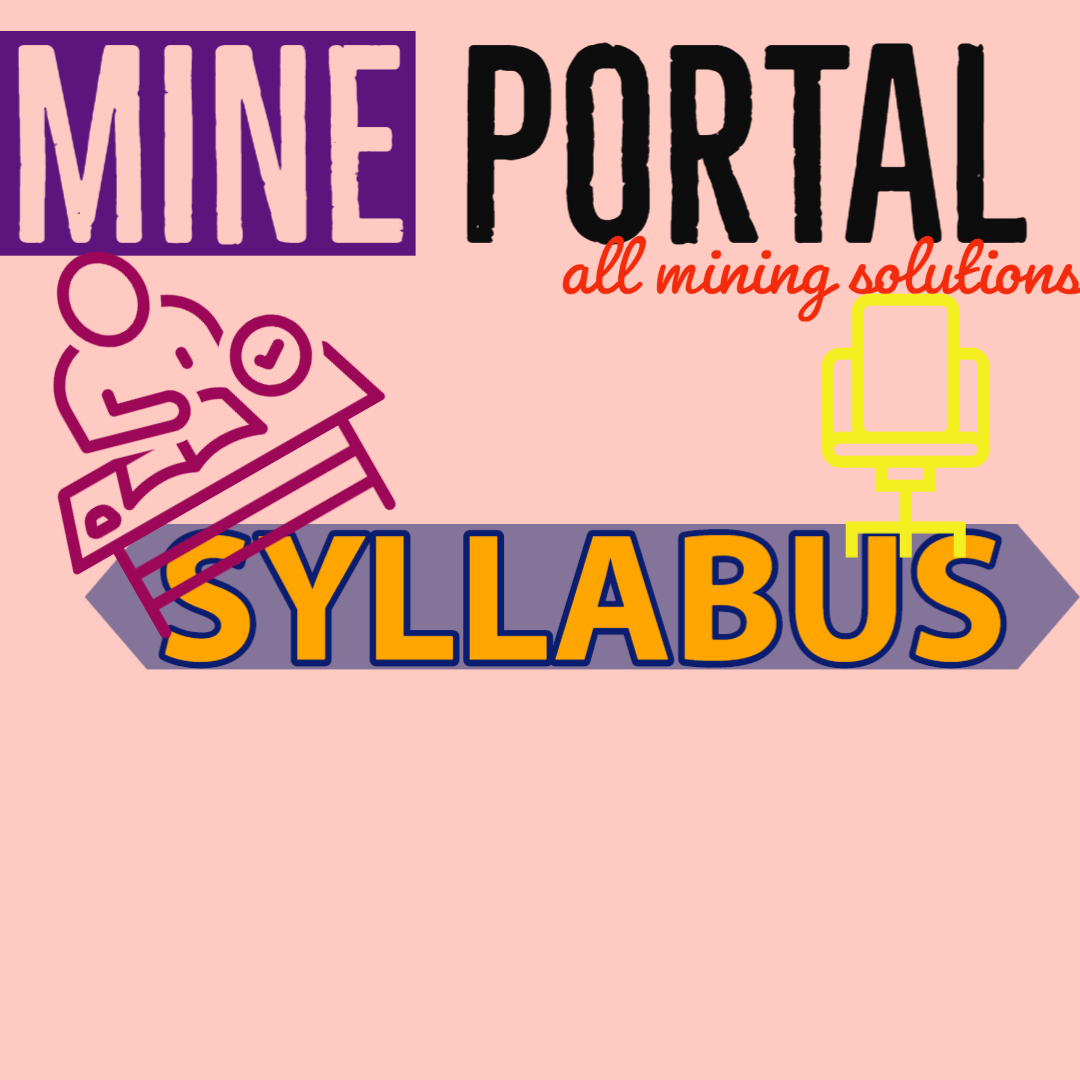
FMR-MINE MANAGEMENT LEGISLATION & GENERAL SAFETY DGMS EXAM SYLLABUS
FIRST CLASS MANAGER’S CERTIFICATE OF COMPETENCY(RESTRICTED)
(UNDER METAL MINES REGULATIONS, 1961)
MINE MANAGEMENT, LEGISLATION AND GENERAL SAFETY
MINE MANAGEMENT:
Introduction: Evolution of management; theory and practice; principles of scientific management; elements of management function; planning; organization and control; structure and design of organization for mining enterprises.
Personal Management: Selection, training and development of human resources for mining enterprises; leadership;study of traditional leader behaviour; autocratic, democratic and Laissez-Faire behaviours.
Production Management: Determination of norms and standards of operations by work study, analysis of mine capacities and capability; production planning, scheduling and control; short term and long term planning; productivity; concepts and measurements; application of Ergonomics in mine operation.
Financial Management: Capital budgeting techniques for mining project, project evaluation; payback period and IRR;methods of cost analysis and cost control; break-even charts; working capital management.
Mining Environment: EIA (Environment Impact Assessment), EMP(Environment Management Plan), ETP (Effluent Treatment Plant), STP (Sewerage Treatment Plant), STP (Sewerage Treatment Plant), threat to environment from underground and surface mining, means of mitigation, treatment of pollutants, monitoring systems, water management;mine closure plan; R&R (rehabilitation and re-settlement).RFCTLARR Act, 2013 and laws related to forest land.Technical and biological reclamation and top soil management.
Economic Impact of Mining: Economics of mining effect on community –before, during and after mining.
Materials Management for mining sector.
Behavioural Sciences for Management: Conflict management; conflict in organization; sources of conflict; dealing with conflict; organizing for conflict resolution; conflict and growth; Individual motivation; two way personal communication.
Industrial Accident: Study of human factors of industrial accidents; theircauses and remedies.
LEGISLATION:
Health and Safety Laws: The Mines Act, 1952; Mines Rules 1955, Metal Mine Regulation, 1961, Mines Rescue Rules,1985,Provisions of, Central Electricity Authority (Measures relating to Safety and Electric Supply) Regulations, 2010 applicable to mines; Mine Vocational Training Rules, 1966, other rules and legislation as applicable to opencast Metal mines.
GENERAL SAFETY:-
Safety in Mines: Duty of care, Occupational hazards of mining, causes and prevention of accidents and their classification; accident statistics; frequency rate andseverity rates; cause-wise analysis, basic causes of accident occurrence; investigation into accidents and accident report; in-depth study into various causes of accidents, measures for improving safety in mines; TRAP (take responsibility in accident prevention); cost of accident; SMP (Safety Management Plan); Elements of SMP, Preparation of SMP, Standard Operating Procedure (SOP) and Hazard Management Plans in opencast mines, dealing with accidents and emergencies in opencast mines, Causes of accident or incident, Accident Investigation methods and steps, Accident / Incident reporting, contribution of human elements in mine safety, workers participation in safety management; ISO and safety audit; safety conferences; tripartite and bipartite committees; role of information technology in safety management.
Risk Management: Theory and application, baseline, continuous and issue based risk assessment, how they are applied to technical areas, hazard identification, risk assessment techniques, Work Place Risk Assessment and Control (WRAC), Job Safety Analysis (JSA), Risk Matrix, Risk Management Options, Hierarchy of controls, Control Effectiveness, means of managing (minimizing or eliminating) risk, computer application and simulations, manager’s role in risk management,due diligence, application of risk assessment and risk management with reference to due diligence, Concept of Triggered Action Response Plan (TARP).
Airbone dust:- Generation, dispersion, measurement and control; suppression and treatment of mine dust; sampling and analysis of air-borne dust, Hazards due to dust in mines.
Mine fires:- Cause of mine fires, spontaneous combustion, dealing with mine fires; firefighting organization; fires in quarries over developed pillars; coal stack and waste dump fires, Hazards due to extraction of developed pillars, its mitigation, Hazards due to extraction of fiery seam or hot strata.
Inrush of water: Hazards of opencast mining near water bodies, rivers, mitigation
Extreme weather condition: Occupational hazards in surface mining and precautions
Biological Hazards, Chemical Hazards
Working at heights
Mine Gases: Generation, Properties and Effects, Detection of Mine Gases, Methanometers and Multi gas Detectors, Gas Chromotograph, Flame Safety Lamps.
Mine explosions: Explosion in quarries over developed pillars, Water gas explosion.
Disaster management: Rescue and recovery; procedure and responsibilities, safety of persons engaged in emergency response, investigations and reports; assessment of damage, mine rescue; mine gases and their physiological effects; rescue equipments; resuscitation and reviving apparatus; selection and training for rescue work.
Emergency Response Plan: Preparation of emergency response plan, Structure of emergency response system, roles and responsibilities, Emergency services, equipments and procedures, emergency control rooms.
First aid and ambulance
Notified and occupational diseases: Silicosis and pneumoconiosis., physiological aspects of breathing in dust laden atmosphere; dust sampling and sampling instruments; methods of counting and analysis; other mines diseases and their symptoms; preventions and treatment.
Lighting: General principles of artificial lighting; lighting standards and their assessment.
Sanitation and health in mines
Safety related issues in Crushing and coal handling and transport system.


No comments added yet!